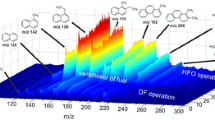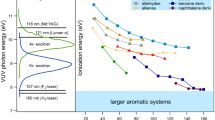Abstract
The on-line analysis of single aerosol particles with mass spectrometrical methods is an important tool for the investigation of aerosols. Often, a single laser pulse is used for one-step laser desorption/ionisation of aerosol particles. Resulting ions are detected with time-of-flight mass spectrometry. With this method, the detection of inorganic compounds is possible. The detection of more fragile organic compounds and carbon clusters can be accomplished by separating the desorption and the ionisation in two steps, e.g. by using two laser pulses. A further method is, using a heated metal surface for thermal desorption of aerosol particles. If an ultraviolet laser is used for ionisation, a selective ionisation of polycyclic aromatic hydrocarbons (PAH) and alkylated PAH is possible via a resonance-enhanced multiphoton-ionisation process. Laser velocimetry allows individual laser triggering for single particles and additionally delivers information on aerodynamic particle diameters. It was shown that particles deriving from different combustion sources can be differentiated according to their PAH patterns. For example, retene, a C4-alkylated phenanthrene derivative, is a marker for the combustion of coniferous wood. In this paper, the first field application of a thermal desorption resonance-enhanced multiphoton-ionisation single particle time-of-flight mass spectrometer during a measurement campaign in Augsburg, Germany in winter 2010 is presented. Larger PAH-containing particles (i.e. with aerodynamic diameters larger than 1 μm), which are suspected to be originated by re-suspension processes of agglomerated material, were in the focus of the investigation. Due to the low concentration of these particles, an on-line virtual impactor enrichment system was used. The detection of particle-bound PAH in ambient particles in this larger size region was possible and in addition, retene could be detected on several particles, which allows to identify wood combustion as generic source of these particles. The observed diurnal distribution of these larger particles, however, support the origin by traffic induced re-suspension of sedimented/agglomerated material.

TD-REMPI mass spectrum of a single particle from ambient air exhibiting an aerodynamic diameter of 1.3 μm, showing typical PAH masses. The intense peak at m/z = 234 (retene) allows to identify wood combustion as a generic source of this particle







Similar content being viewed by others
References
Dockery DW, Pope CA, Xu XP, Spengler JD, Ware JH, Fay ME, Ferris BG, Speizer FE (1993) N Engl J Med 329(24):1753
Zanobetti A, Schwartz J, Samoli E, Gryparis A, Touloumi G, Atkinson R, Le Tertre A, Bobros J, Celko M, Goren A, Forsberg B, Michelozzi P, Rabczenko D, Ruiz EA, Katsouyanni K (2002) Epidemiology 13(1):87
Gauderman WJ, Avol E, Gilliland F (2004) N Engl J Med 351(25):2653
Oberdörster G, Gelein RM, Ferin J, Weiss B (1995) Inhal Toxicol 7(1):111
Oberdörster G, Ferin J, Gelein R, Soderholm SC, Finkelstein J (1992) Environ Health Perspect 97:193
Peters A, Wichmann HE, Tuch T, Heinrich J, Heyder J (1997) Am J Respir Crit Care Med 155(4):1376
Pope CA, Thun MJ, Namboodiri MM, Dockery DW, Evans JS, Speizer FE, Heath CW (1995) Am J Respir Crit Care Med 151:669
Wichmann HE, Spix C, Tuch T, Wolke G, Peters A, Heinrich J, Kreyling WG, Heyder J (2000) Research Report Health Effects Institut 98(98):5
Durant JL, Thilly WG, Hemond HF, Lafleur AL (1994) Environ Sci Technol 28(12):2033
Villalobos-Pietrini R, Hernandez-Mena L, Amador-Munoz O, Munive-Colin Z, Bravo-Cabrera JL, Gomez-Arroyo S, Frias-Villegas A, Waliszewski S, Ramirez-Pulido J, Ortiz-Muniz R (2007) Mutat Res Genet Toxicol Environ Mutagen 634(1–2):192
Moller P, Folkmann JK, Forchhammer L, Bruner EV, Danielsen PH, Risom L, Loft S (2008) Cancer Lett 266(1):84, Oxidative Stress and Carcinogenesis Special Issue
Mahadevan B, Marstont CP, Dashwood WM, Li YH, Pereira C, Baird WM (2005) Chemical Research In Toxicology 18(2):224
Sklorz M, Briede JJ, Schnelle-Kreis J, Liu Y, Cyrys J, de Kok TM, Zimmermann R (2007) J Toxicol Environ Health A (Current Issues) 70:1866
Nielsen SE, Young JF, Daneshwar B, Lauridsen ST, Knuthsen P, Sandstrom B, Dragsted LO (1999) Br J Nutr 81:447
Delfino RJ, Staimer N, Tjoa T, Arhami M, Polidori A, Gillen DL, Kleinman MT, Schauer JJ, Sioutas C (2010) Environ Health Perspect 118(6):756
Kraus U, Breitner S, Schnelle-Kreis J, Cyrys J, Lanki T, Räckerl R, Schneider A, Bräske I, Gu J, Devlin R, Wichmann HE, Zimmermann R, Peters A (2011) Inhal Toxicol 23(7):431
Sinha MP (1984) Review of Scientic Instruments 55(6):886
Sinha MP, Friedlander SK (1985) Anal Chem 57(9):1880
Marijnissen J, Scarlett B, Verheijen P (1988) Journal of Aerosol Science 19(7):1307
Prather KA, Nordmeyer T, Salt K (1994) Anal Chem 66(9):1403
Carson PG, Neubauer KR, Johnston MV, Wexler AS (1995) Journal of Aerosol Science 26(4):535
Carson PG, Johnston MV, Wexler AS (1997) Rapid Communications In Mass Spectrometry 11(9):993
Murphy DM, Thomson DS (1995) Aerosol Science and Technology 22(3):237
Liu DY, Rutherford D, Kinsey M, Prather KA (1997) Anal Chem 69(10):1808
Reilly PTA, Gieray RA, Whitten WB, Ramsey JM (1998) Environ Sci Technol 32(18):2672
Wood SH, Prather KA (1998) TrAC Trends in Analytical Chemistry 17(6):346
Hinz KP, Kaufmann R, Spengler B (1996) Aerosol Science and Technology 24(4):233
Suess DT, Prather KA (1999) Chem Rev 99(10):3007
Zimmermann R, Ferge T, Galli M, Karlsson R (2003) Rapid Communications In Mass Spectrometry 17(8):851
Hinz KP, Greweling M, Drews F, Spengler B (1999) Journal of the American Society For Mass Spectrometry 10(7):648
Bhave PV, Fergenson DP, Prather KA, Cass GR (2001) Environ Sci Technol 35(10):2060
Song XH, Faber NKM, Hopke PK, Suess DT, Prather KA, Schauer JJ, Cass GR (2001) Anal Chim Acta 446(1–2):329
Healy RM, Hellebust S, Kourtchev I, Allanic A, O’Connor IP, Bell JM, Healy DA, Sodeau JR, Wenger JC (2010) Atmospheric Chemistry and Physics 10(19):9593
Silva PJ, Prather KA (2000) Anal Chem 72(15):3553
Zimmermann R, Van Vaeck L, Davidovic M, Beckmann M, Adams F (2000) Environ Sci Technol 34(22):4780
Ferge T, Karg E, Schröppel A, Tobias H, Frank M, Gard E, Zimmermann R (2004) Journal of Aerosol Science 35(Supplement 2):1169
Morrical BD, Fergenson DP, Prather KA (1998) Journal of the American Society For Mass Spectrometry 9(10):1068
Lubman DM, Kronick MN (1982) Anal Chem 54(13):2289
Bente M, Sklorz M, Streibel T, Zimmermann R (2008) Anal Chem 80(23):8991
Butcher DJ, Goeringer DE, Hurst GB (1999) Anal Chem 71(2):489
Mühlberger F, Zimmermann R, Kettrup A (2001) Anal Chem 73(15):3590
Bente M, Adam T, Ferge T, Gallavardin S, Sklorz M, Streibel T, Zimmermann R (2006) International Journal of Mass Spectrometry 258(1–3):86
Bente M, Sklorz M, Streibel T, Zimmermann R (2009) Anal Chem 81(7):2525
Jayne JT, Leard DC, Zhang X, Davidovits P, Smith KA, Kolb CE, Worsnop DR (2000) Aerosol Science and Technology 33(1):49
Liu P, Ziemann PJ, Kittelson DB, McMurry PH (1995) Aerosol Science and Technology 22(3):293
Liu P, Ziemann PJ, Kittelson DB, McMurry PH (1995) Aerosol Science and Technology 22(3):314
Drewnick F, Hings SS, DeCarlo P, Jayne JT, Gonin M, Fuhrer K, Weimer S, Jimenez JL, Demerjian KL, Borrmann S, Worsnop DR (2005) Aerosol Science and Technology 39:637
Svane M, Gustafsson TL, Kovacevik B, Noda J, Andersson PU, Nilsson ED, Pettersson JB (2009) Aerosol Science and Technology 43(7):653
Orasche J, Schnelle-Kreis J, Abbaszade G, Zimmermann R (2011) Atmospheric Chemistry and Physics Discussions 11(5):15255
Cass GR (1998) TrAC Trends in Analytical Chemistry 17(6):356
Schnelle-Kreis J, Sklorz M, Orasche J, Stolzel M, Peters A, Zimmermann R (2007) Environ Sci Technol 41(11):3821
H. Lamberg, K. Nuutinen, J. Tissari, J. Ruusunen, P. Yli-Piril, O. Sippula, M. Tapanainen, P. Jalava, U. Makkonen, K. Teinil, K. Saarnio, R. Hillamo, M.R. Hirvonen, J. Jokiniemi, Atmospheric Environment (in press), (2011).
Acknowledgements
The experimental setup for this work was enabled by the financial support of the Deutsche Forschungsgemeinschaft (German Science Foundation, grant numbers ZI 764/1-1 and ZI 764/1-2).
Author information
Authors and Affiliations
Corresponding author
Additional information
Published in the special issue Aerosol Analysis with guest editor Ralf Zimmermann.
Rights and permissions
About this article
Cite this article
Oster, M., Elsasser, M., Schnelle-Kreis, J. et al. First field application of a thermal desorption resonance-enhanced multiphoton-ionisation single particle time-of-flight mass spectrometer for the on-line detection of particle-bound polycyclic aromatic hydrocarbons. Anal Bioanal Chem 401, 3173–3182 (2011). https://doi.org/10.1007/s00216-011-5438-9
Received:
Revised:
Accepted:
Published:
Issue Date:
DOI: https://doi.org/10.1007/s00216-011-5438-9




